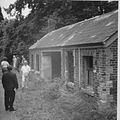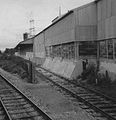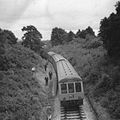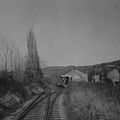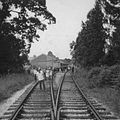- Moretonhampstead and South Devon Railway
-
Moretonhampstead and South Devon Railway Locale England Dates of operation 1866–1972 Successor South Devon Railway Track gauge 7 ft 0¼ in Length 12.35 miles Headquarters Newton Abbot Moretonhampstead and South Devon Railway Legend
Moretonhampstead 
A382 road 
Lustleigh 
Hawkmoor Halt later renamed Pullabrook 
Bovey 
Brimley Halt 


Teign Valley Line 
Heathfield (Devon) 
A38 road 
Teigngrace Halt 


GWML to London 
Newton Abbot 
GWML to Penzance
The Moretonhampstead and South Devon Railway was a 7 ft 0 1⁄4 in (2,140 mm) broad gauge railway which linked the South Devon Railway at Newton Abbot railway station with Bovey Tracey and Moretonhampstead, Devon, England.[1]Contents
History of the line
In 1861 the Moretonhampstead and South Devon Railway company was formed at the Globe Hotel in Exeter, and in 1862 the bill for making the railway was given Royal Assent. Work on the line commenced in 1863 and the major earthworks (with cuttings and embankments, many still visible today) were complete. All the granite used for construction of the bridges was cut from Lustleigh Cleave. The line was 12 miles, 28 chains (20 km) long.[2]
Following a Board of Trade inspection, the branch line opened to the public on 26 June 1866. A public holiday was observed, with people turning out to witness the first journey from Newton Abbot to Moretonhampstead.
In 1892, the 7 ft 0 1⁄4 in (2,140 mm) broad gauge line was replaced by a 4 ft 8 1⁄2 in (1,435 mm) standard gauge format, taking only 32 hours and 60 men to complete - part of the wider conversion of the whole network.
The railway brought tourists to the area. Other users of the service were local industries: farmers' produce, nursery plants and blacksmiths' products were sent by train.
Traffic grew from 1860 to the 1930s and then went into decline. Despite a significant summer tourist trade, featuring in many contemporary guide books, traffic on the branch over the year was not enough to cover rising costs.
The station was used in 1931 for the film 'Hound of the Baskervilles', its name being temporarily changed (Ewans 1964).
In 1957, the possibility of closure was reported in the Mid Devon Advertiser and on 28 February 1959 the last passenger service ran down the line, although a freight operation still ran. The line closed on 6 April 1964.
The last special passenger train ran as far as Bovey Tracey on 5 July 1970. Oil and china clay trains continued to operate occasionally on the south section of the line below Heathfield for several years,[3] but the remaining section of the branch was taken out of use in 2009 when 'temporary stop blocks' were placed on the line 53 chains (1.1 km) from the junction at Newton Abbot.[4]
Several miles of the line between Bovey and Lustleigh, some of which is now a path open to the public, are planned by the council to become a cycle track. The old Lustleigh station house is visible from the old railway bridge at Brookfield, as are the Brookfield, Caseley and Knowle bridges.
Chronology
- 1862 Moretonhampstead and South Devon Railway authorised by Act of Parliament
- 1866 Railway opened
- 1872 Amalgamated with the South Devon Railway Company
- 1876 South Devon Railway amalgamated with the Great Western Railway
- 1882 Standard gauge Teign Valley Railway opened from Heathfield
- 1892 Broad gauge converted to standard gauge
- 1928 Brimley Halt opened
- 1948 Great Western Railway nationalised into British Railways
- 1955 Hawkmoor Halt renamed to Pullabrook Halt
- 1959 Passenger trains withdrawn
- 1964 Goods trains withdrawn beyond Bovey
- 1970 Goods trains withdrawn beyond Heathfield
The last train
These pictures show the journey of the last special passenger train to Bovey Tracey on 5 July 1970.
References
- ^ Beck, Keith; Copsey, John (1990). The Great Western in South Devon. Didcot: Wild Swan Publications. ISBN 0-906867-90-8.
- ^ Rowe J, in Book of Lustleigh, 2001
- ^ Jenkins, S C; Pomroy, L J (1989). The Moretonhampstead and South Devon Railway. Oxford: Oakwood Press. ISBN 0-85361-389-3.
- ^ Jacobs, G.A. (2009). "Trackwatch". Modern Railways (Ian Allan) 66 (731): 17. ISSN 0026-8356.
See also
- Haytor Granite Tramway granite siding near Bovey
Categories:- 7ft gauge railways
- Rail transport in Devon
- Great Western Railway constituents
- Closed railway lines in South West England
- Railway companies established in 1862
- Railway lines opened in 1866
- Railway companies disestablished in 1872
Wikimedia Foundation. 2010.

